Are you ready to dive into the world of gardening and learn what supplies, tools, and techniques you need to plant and care for your plants effectively?
Welcome to the Essentials Guide: What Do You Need to Plant – Tips and Tricks. In this article, I will provide you with valuable insights to help you succeed in your gardening journey. Whether you’re a beginner or an experienced gardener, these tips and tricks will equip you with the knowledge you need to create a thriving indoor garden.
Key Takeaways:
- Choose plants based on the amount of natural light your space receives and consider any obstructions that may affect sunlight.
- Select plants that align with your schedule, such as low-maintenance or attention-loving plants.
- Be mindful when watering, checking soil moisture and adjusting watering frequency accordingly.
- Create a suitable humidity level for your plants, especially tropical ones, by grouping them together or using a humidifier.
- Maintain stable temperatures for your plants, avoiding hot and cold drafts.
Choosing Plants Based on Light
The first step to successful planting is understanding the importance of choosing plants that match the natural light conditions in your space. Different plants have different light requirements, and providing the right amount of light is crucial for their growth and overall health. Here are some tips to help you select the perfect plants based on the available light:
- South-facing windows: These windows receive the most sunlight throughout the day, making them ideal for plants that require bright light. Consider plants like succulents, cacti, and flowering houseplants that thrive in direct sunlight.
- East and west-facing windows: These windows provide moderate light levels. You can choose plants that can tolerate medium light conditions such as pothos, peace lilies, and spider plants. These plants are known for their adaptability and can thrive in a variety of lighting conditions.
- North-facing windows: These windows receive the least amount of direct sunlight, making them suitable for plants that prefer low light. Choose shade-loving plants like ferns, snake plants, and ZZ plants that can thrive in these conditions.
It’s important to note that the natural light in your space may be affected by obstructions such as buildings, trees, or nearby structures. Ensure you consider any factors that may block sunlight when choosing plants. Additionally, be aware of the light levels your plants can tolerate to ensure their optimal growth.
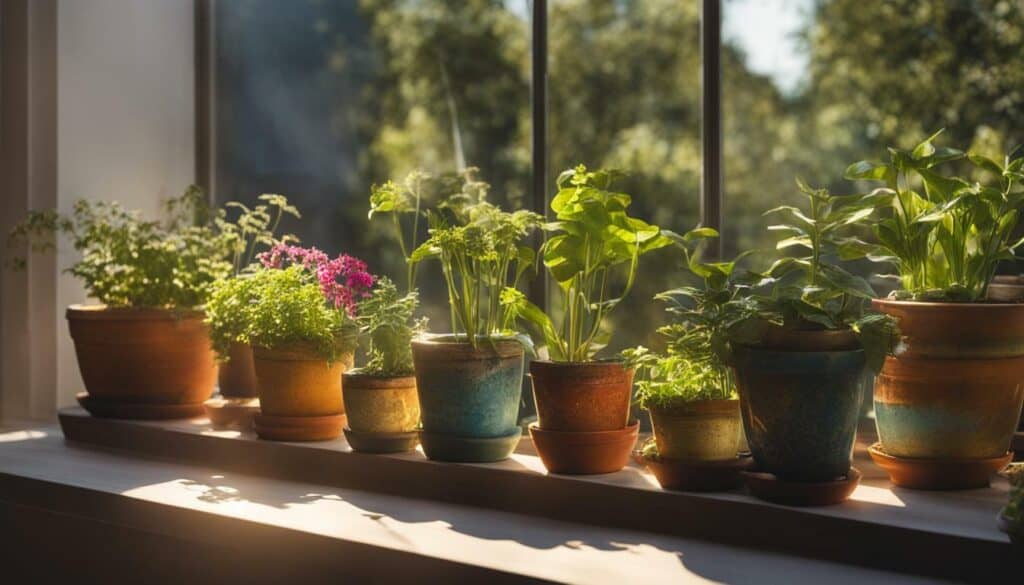
Creating a Bright and Beautiful Space
By selecting plants that match the available light in your space, you’ll create a harmonious and thriving indoor garden. Whether you have a sun-drenched south-facing window or a cozy corner with minimal light, there are plants that can flourish in every environment. Remember to regularly assess the light conditions in your home and adjust your plant selection accordingly. With the right plants and the perfect amount of light, your indoor garden will be a stunning display of nature’s beauty.
| Light Level | Windows | Examples of Plants |
|---|---|---|
| Bright Light | South-facing Windows | Succulents, Cacti, Flowering Houseplants |
| Moderate Light | East and West-facing Windows | Pothos, Peace Lilies, Spider Plants |
| Low Light | North-facing Windows | Ferns, Snake Plants, ZZ Plants |
“Plants are like people; they thrive when they have access to the right amount of light.” – Unknown
Picking Plants that Work with Your Schedule
Finding the right plants that can thrive in your home or garden and align with your schedule is key to cultivating a successful green space. Whether you’re a busy professional who can only spare a few minutes for plant care or a dedicated plant enthusiast with ample time to tend to your leafy friends, there are options that will suit your lifestyle.
For those who prefer low-maintenance plants, look no further than drought-tolerant varieties like succulents, ZZ plants, and snake plants. These plants have adapted to survive in arid conditions and can handle periods of neglect. They require minimal watering and can go for weeks without attention, making them perfect for those who may forget to water on occasion.
If you enjoy spending more time with your plants and providing them with extra care, consider attention-loving plants like air plants, orchids, or ferns. These plants thrive on regular attention, such as misting, pruning, and careful monitoring of their water and light needs. While they may require a bit more effort, the joy of nurturing these plants can be immensely rewarding.
Table: Low-Maintenance and Attention-Loving Plants
| Low-Maintenance Plants | Attention-Loving Plants |
|---|---|
| Succulents | Air Plants |
| ZZ Plants | Orchids |
| Snake Plants | Ferns |
Remember, even low-maintenance plants require some level of care. It’s important to observe your plants and adjust their care as needed. Factors such as light, temperature, and humidity can also impact plant health, so be sure to consider these factors when selecting plants that work with your schedule.
By choosing plants that align with your lifestyle and schedule, you can create a harmonious balance between your daily routine and the needs of your plants. This will not only ensure their survival but also allow you to enjoy the beauty and benefits of greenery in your living space.
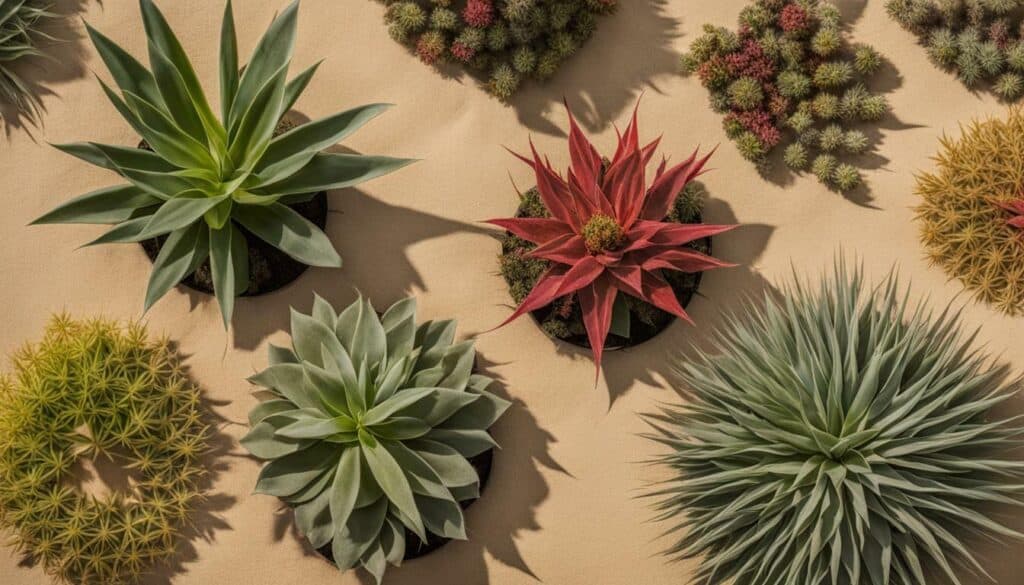
Being Mindful When Watering
Watering your plants correctly is crucial for their health and growth, so let’s discover the essential tips for achieving the perfect balance.
Firstly, it’s important to be mindful of both underwatering and overwatering. Finding the sweet spot can be a bit tricky, but with some practice and observation, you’ll be able to meet your plants’ moisture needs effectively.
One key factor to consider is the moisture level of the soil. To determine if your plant needs watering, simply stick your finger about 2 inches deep into the soil. If it feels dry at that depth, it’s time to water. If it’s still moist, hold off on watering for a few more days.
Another tip is to use warm water when watering your plants. This helps prevent shocking the roots and allows for better uptake of water and nutrients. Additionally, when watering, it’s best to water directly at the base of the plant to avoid wetting the leaves unnecessarily.
| Signs of Underwatering | Signs of Overwatering |
|---|---|
| – Dry, shriveled leaves | – Yellowing or browning leaves |
| – Wilting or drooping appearance | – Mushy or rotting roots |
| – Slow growth | – Foul smell from the soil |
Remember, each plant has different water requirements, so it’s essential to understand the specific needs of your plants. Some plants prefer consistently moist soil, while others prefer to dry out between waterings. Researching the watering needs of your specific plants will help you provide the best care for them.
Watering Frequency Guidelines
- For most houseplants, it’s recommended to water once the top inch of soil feels dry.
- In warmer months or if your plant is positioned in a brighter location, you may need to water more frequently.
- During winter or in lower light conditions, watering frequency may decrease.
- Plants in well-draining soil and pots with drainage holes may require more frequent watering.
- Plants in heavy, compacted soil or pots without drainage holes will require less frequent watering to avoid waterlogged roots.
By being mindful of your plant’s watering needs, checking the soil moisture regularly, using warm water, and watering at the base of the plant, you’ll be well on your way to keeping your plants happy and healthy.
Raising Humidity Levels When Needed
Some plants thrive in higher humidity levels, so let’s explore how to create the perfect environment for them. A humid microclimate can be beneficial for tropical plants, as it mimics their natural habitat. One way to increase humidity is by grouping plants together. When plants are placed close to each other, they create a microclimate with increased moisture levels.
Another option to raise humidity is by using a humidifier. This device releases moisture into the air, creating a more suitable environment for plants that require high humidity. The humidifier should be placed near the plants, ensuring that the mist reaches them effectively.
| Plant Type | Preferred Humidity Level |
|---|---|
| Tropical Plants | Around 60-70% |
| Desert Plants | Around 40-50% |
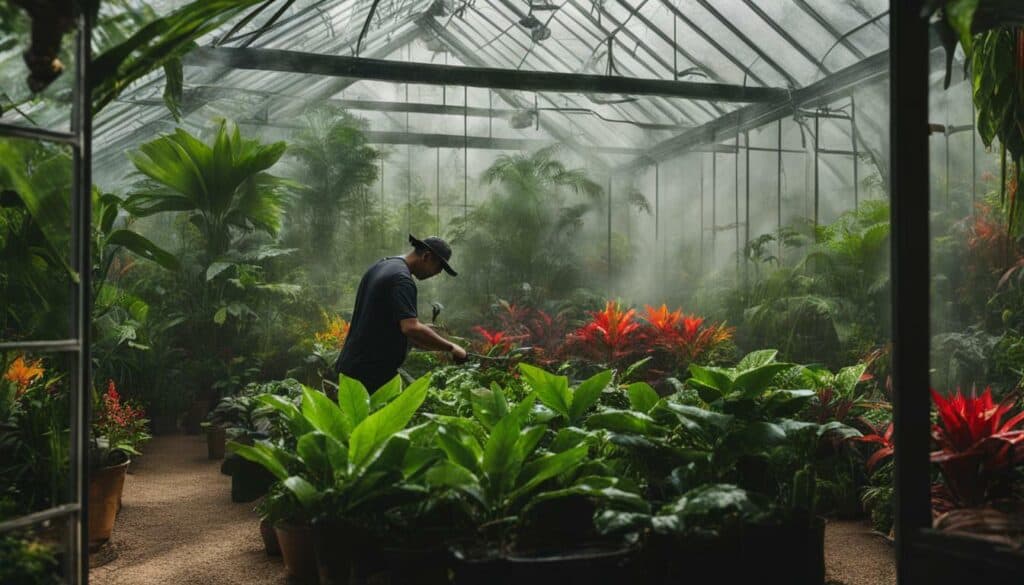
It’s important to note that not all plants require high humidity. Desert plants, such as cacti and succulents, prefer drier air and lower humidity levels. These plants have adapted to arid environments, so excessive moisture can damage their roots and lead to rot. If you have a mix of plants with different humidity preferences, it may be best to separate them into different areas of your home.
Grouping Plants for Humidity:
- Choose plants with similar humidity requirements.
- Group them together on a tray filled with pebbles and water.
- As the water evaporates, it increases the humidity around the plants.
By creating the right humidity levels for your plants, you can promote healthy growth and prevent issues such as leaf browning or drying. Remember to regularly monitor the humidity levels and adjust as needed to provide the best conditions for your indoor plants.
Keeping Temperatures Stable
Just like humans, plants prefer stable temperatures, so understanding how to provide them with a consistent environment is essential. Fluctuations in temperature can stress plants and hinder their growth. In this section, I will share some tips on how to maintain stable temperatures for your plants.
One of the most important things to consider is avoiding hot and cold drafts. Plants should be kept away from heating vents, air conditioning units, and drafty windows or doors. These sources of temperature fluctuations can cause stress to your plants and even lead to damage.
It’s also crucial to keep the temperature within a suitable range for your plants’ specific needs. Most indoor plants prefer temperatures between 65 and 85 degrees Fahrenheit (18 to 29 degrees Celsius). However, some plants may have different temperature requirements, so it’s essential to research the specific needs of each plant you have.
Remember, maintaining stable temperatures is just one aspect of caring for your plants. The amount of light, water, and humidity levels are also vital factors to consider. By providing your plants with the right conditions, you’ll create an environment that promotes healthy growth and vibrant foliage.
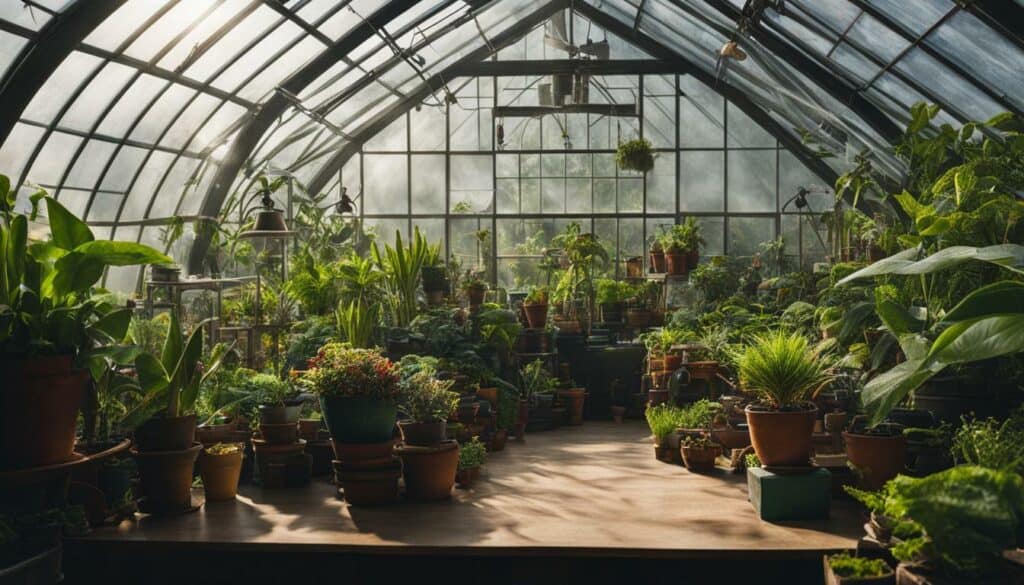
Table: Temperature Recommendations for Common Houseplants
| Plant | Temperature Range (Fahrenheit) |
|---|---|
| Spider Plant | 55-80 |
| Pothos | 65-85 |
| Peace Lily | 65-85 |
| Snake Plant | 60-85 |
| ZZ Plant | 60-75 |
By following these tips and maintaining stable temperatures, you’ll provide the ideal conditions for your plants to thrive. Remember to always consider the specific needs of each plant and adjust accordingly. With a little care and attention to temperature control, your indoor plants will flourish and bring beauty to your space.
Knowing When to Skip the Fertilizer
Fertilizing your plants can boost their growth, but it’s important to know when to provide that extra nutrient support and when to hold back. Understanding the needs of your plants and the right timing for fertilization can make a significant difference in their overall health and vitality.
Houseplants and outdoor plants have different requirements when it comes to fertilizing. Houseplants generally require less fertilizer compared to outdoor plants, as they have a more controlled environment and slower growth rates. It’s best to fertilize houseplants during the growing season, which is typically from spring to early fall. During this time, plants are actively growing and can benefit from the additional nutrients.
When fertilizing your houseplants, follow the instructions provided on the fertilizer packaging. It’s important not to overdo it, as too much fertilizer can burn the roots and harm the plant. Always dilute the fertilizer as directed and apply it to moist soil to prevent root damage. If you’ve recently changed the soil of your houseplant, it’s best to hold off on fertilizing for a few months to allow the plant to acclimate to its new environment.
Outdoor plants, on the other hand, may require more frequent fertilization, especially if they are grown in nutrient-poor soil or have heavy blooming periods. The growing season and the specific needs of the plant should guide your fertilization schedule. Some outdoor plants may benefit from monthly fertilization, while others may only require fertilization once or twice a year.
It’s important to note that not all plants necessarily require fertilization. Some plants, like succulents and cacti, have adapted to thrive in nutrient-poor environments and may not need additional fertilizer. Always research the specific needs of your plants to determine if fertilization is necessary.
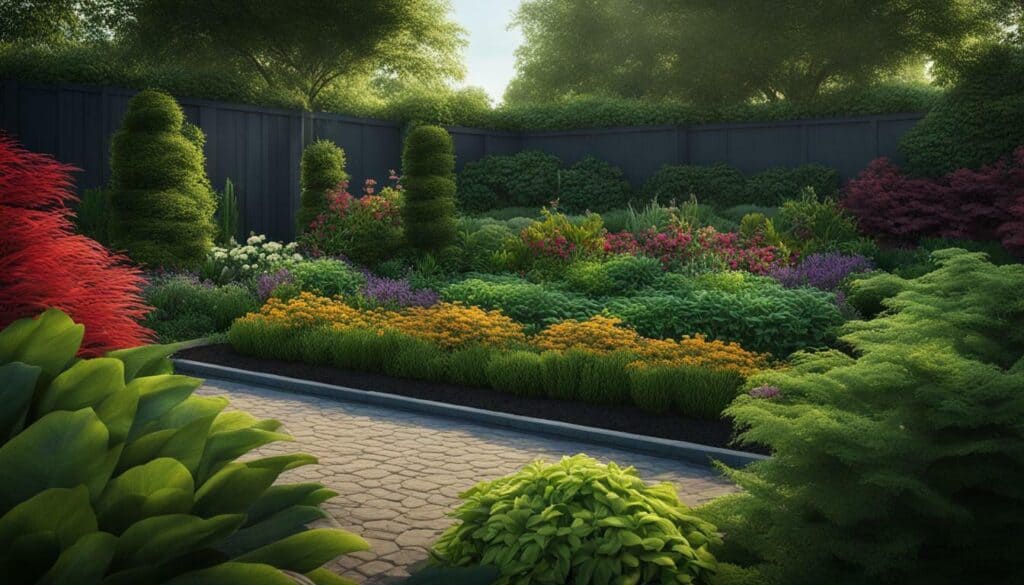
Remember, fertilizing your plants is just one aspect of their care. Providing adequate water, light, and temperature conditions is equally important for their overall well-being. By knowing when to skip the fertilizer and understanding your plants’ unique needs, you can ensure they receive the proper care and thrive in their environment.
Shopping from a Reliable Source
When it comes to buying plants, choosing a reliable source is crucial to ensure you bring home healthy and well-cared-for green companions. Reputable sources, such as specialized plant nurseries or local garden centers, are your best bet. These places typically have knowledgeable plant experts who can assist you in selecting the right plants for your needs and provide guidance on plant care.
Department stores and supermarkets may offer plants at a lower price, but they often lack the expertise and care required to maintain the health of the plants. The plants sold in these establishments may not receive adequate attention and may not be well-suited for your specific environment.
By shopping from reliable sources, you can have confidence that the plants you bring home are healthy, well-nurtured, and more likely to thrive in your care. You can also rely on the experts at these establishments for advice on plant care, including watering, lighting, and fertilizing.
Expert Quote:
“When purchasing plants, it’s important to choose reputable sources. These establishments not only provide high-quality plants but also offer valuable knowledge and insights on plant care. It’s always worth the investment to ensure you’re bringing home healthy and well-cared-for plants.”
By prioritizing shopping from reputable sources, you can set yourself up for success in your gardening journey. Remember, the health and well-being of your plants start from the moment of purchase, so choose wisely and enjoy the rewards of a thriving indoor garden.
Showing a Little TLC at First
Just like we all need a little extra care and attention when we first start something new, newly acquired plants benefit from some extra love and monitoring as they settle in. This is the time to establish a strong foundation for their growth and ensure they thrive in their new environment. By providing the right amount of watering, temperature, and sunlight, you can help them adjust and flourish.
When it comes to watering, it’s crucial to strike the right balance. Overwatering can lead to root rot and other issues, while underwatering can cause dehydration and stunted growth. To determine the watering needs of your plant, check the soil regularly. Stick your finger about 2 inches deep below the surface; if the soil feels dry, it’s time to water. Remember that different plants have different watering requirements, so it’s essential to understand the specific needs of your newly acquired plant.
“Overwatering can lead to root rot and other issues, while underwatering can cause dehydration and stunted growth.”
In addition to watering, the temperature and sunlight conditions also play a vital role in the well-being of your plant. Most indoor plants thrive in temperatures between 65 and 85 degrees Fahrenheit, so try to maintain a stable temperature within this range. Avoid placing your plant near sources of hot or cold drafts, as extreme temperatures can stress the plant. Also, be mindful of the light requirements of your plant and position it accordingly. Some plants prefer bright, indirect light, while others can tolerate low-light conditions. Observe your plant’s response to its surroundings and make adjustments as needed.
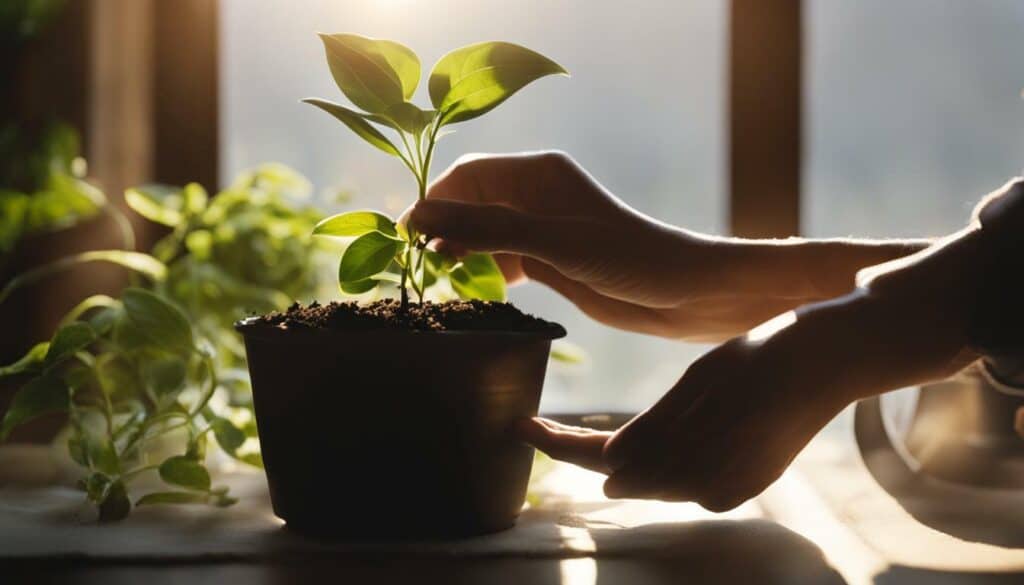
By showing a little TLC and providing extra attention during the initial stages, you can ensure that your newly acquired plant thrives and adapts to its new home. Remember to observe its watering needs, monitor the temperature and sunlight conditions, and make adjustments as necessary. With care and patience, your plant will settle in and reward you with its beauty and vitality.
| Key Points: | Key Takeaways: |
|---|---|
| 1. Water your newly acquired plant carefully, avoiding overwatering or underwatering. | – Overwatering can lead to root rot, while underwatering can cause dehydration. – Check the soil regularly and water when it’s dry 2 inches below the surface. – Different plants have different watering requirements; understand your plant’s needs. |
| 2. Maintain the right temperature and sunlight conditions for your plant. | – Most indoor plants thrive in temperatures between 65 and 85 degrees Fahrenheit. – Avoid placing your plant near hot or cold drafts that can stress the plant. – Observe your plant’s response to light and position it accordingly. |
| 3. Provide extra attention and monitor your plant’s progress. | – Newly acquired plants need time to adapt to their new environment. – Observe and adjust watering, temperature, and sunlight based on your plant’s needs. – Show patience and care as your plant settles in and establishes a strong foundation for growth. |
Additional Tip:
- Consider using a moisture meter to accurately determine when your plant needs watering. This handy tool measures the moisture content in the soil and eliminates any guesswork.
Don’t Be Scared to Repot
Repotting your plants is a necessary step in their growth journey, and understanding how to do it correctly will help your green companions flourish. It’s normal for plants to outgrow their containers over time, and repotting provides them with fresh soil, nutrients, and room to grow. Here are some essential tips to guide you through the repotting process:
- Choose the right time: Spring is generally the best time to repot your plants when they start to show signs of new growth. This allows them to recover quickly and establish themselves in their new home.
- Select the appropriate pot: When choosing a new pot, opt for one that is slightly larger than the current container. This will give your plant enough space to grow without overwhelming it with too much soil. Make sure the pot has drainage holes to prevent waterlogging.
- Prepare the potting mix: Use a high-quality potting mix that is well-draining and rich in nutrients. You can also mix in some perlite or vermiculite to improve the soil’s texture and aeration.
- Gently remove the plant: Carefully remove the plant from its current pot by gently loosening the roots. Be cautious not to damage the root system. If the plant is root-bound (roots tightly packed), you can gently tease them apart to encourage new growth.
- Place the plant in the new pot: Position the plant in the center of the new container, ensuring that the base of the stem is at the same level as before. Fill the remaining space with fresh potting mix, pressing it gently around the roots to secure the plant.
- Water and settle in: After repotting, give your plant a thorough watering to help it settle into its new home. Keep an eye on the soil moisture in the following weeks and adjust your watering routine accordingly.
Remember, not all plants require immediate repotting, so observe your plants regularly to determine when they truly need it. Repotting can be a rewarding experience that promotes healthy growth and vitality in your plants. So don’t be scared to give your green friends a new home!
Beneficial Tip: Prune During Repotting
During the repotting process, it’s an excellent opportunity to give your plant a little haircut. Pruning any dead or damaged foliage will not only improve the appearance of your plant but also promote new growth. Use clean, sterilized pruning shears to make clean cuts, and remove any yellowing or withered leaves. This will ensure that your plant focuses its energy on healthy growth and prevents any potential pests or diseases from spreading.
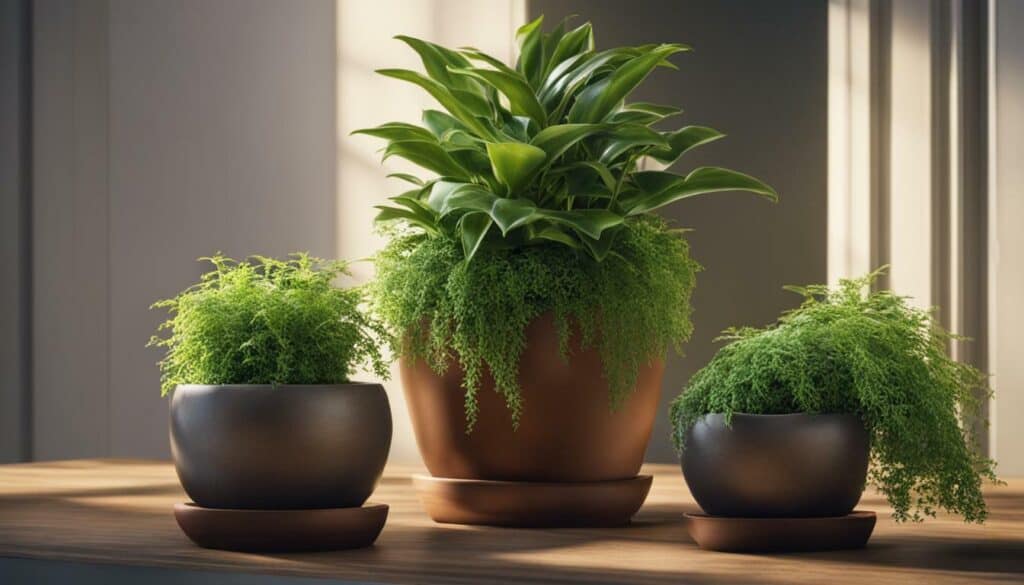
Keeping Drainage in Mind
Adequate drainage is essential for preventing overwatering and maintaining the health of your potted plants, so let’s explore different drainage methods.
One effective method is to use planters with drainage holes. These holes allow excess water to escape, preventing the roots from becoming waterlogged. When using planters with drainage holes, it’s important to place a saucer or tray underneath to catch any water that drains out.
If you have planters without drainage holes, you can add rocks or pebbles to the bottom before adding soil. This creates a space for excess water to collect, keeping the roots above the standing water. However, it’s crucial to monitor the water level and ensure that the roots do not sit in water for prolonged periods.
Additionally, another drainage method is to use a layer of activated charcoal at the bottom of the planter. Activated charcoal helps absorb excess moisture and prevents stagnant water, keeping the soil well-drained and the plant roots healthy.
Table: Pros and Cons of Different Drainage Methods
| Drainage Method | Pros | Cons |
|---|---|---|
| Planters with drainage holes |
|
|
| Rocks or pebbles at the bottom |
|
|
| Activated charcoal |
|
|
By keeping drainage in mind and employing suitable methods, you can create a healthy growing environment for your potted plants. Remember to choose the method that works best for your plants and regularly check the moisture levels to ensure optimal plant growth.
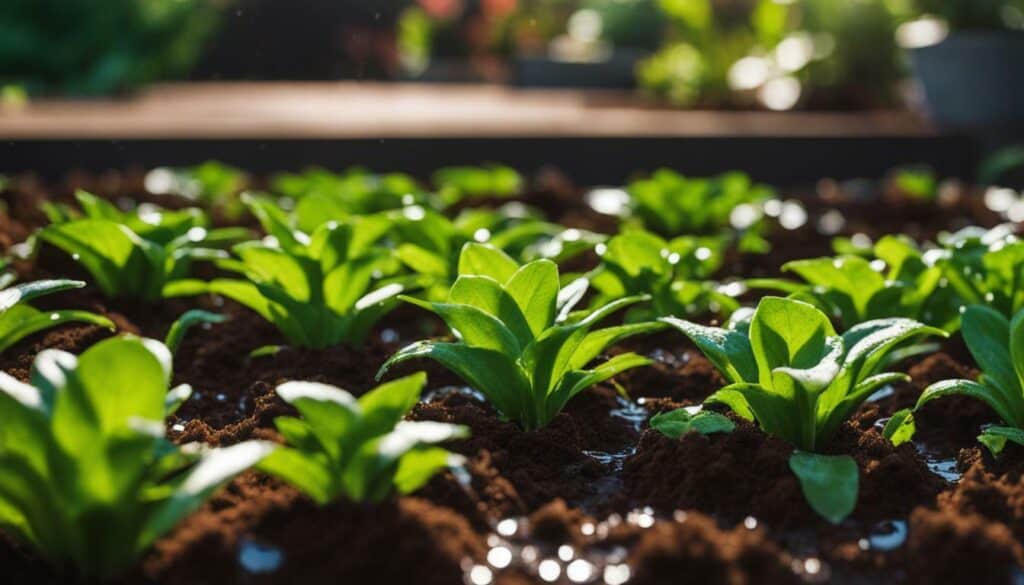
Summary
Adequate drainage is crucial for maintaining the health of your potted plants and preventing overwatering. By using planters with drainage holes, adding rocks or pebbles to the bottom, or incorporating activated charcoal, you can ensure proper drainage and avoid waterlogged roots. Consider the pros and cons of each method and choose the one that suits your plant’s needs best. With proper drainage, your potted plants will thrive in their environment.
Conclusion
By following these essential tips and tricks, you can confidently embark on your gardening journey and enjoy the rewards of a thriving indoor plant collection.
Choosing plants based on your light conditions is crucial for their well-being. Consider the amount of natural light your space receives and select plants that can thrive in that environment. Remember to take into account any obstructions that may affect sunlight and the light levels your plants can tolerate.
Picking plants that work with your schedule is also important. If you have a busy lifestyle, opt for low-maintenance and drought-tolerant plants like succulents, ZZ plants, or snake plants. If you have more time to dedicate to plant care, try attention-loving air plants, orchids, or ferns.
When it comes to watering, be mindful and avoid overwatering. It’s better to underwater than to drown your plants. Check the soil moisture and water only when it’s dry at least 2 inches deep below the surface. Adjust your watering frequency based on the season and the specific needs of each plant. Always use warm water and water directly at the base of the plant.
Raising humidity levels can be beneficial for certain plants. Create a humid microclimate for tropical plants by grouping them together or using a humidifier. On the other hand, desert plants like cacti and succulents prefer dry air, so avoid excessive humidity for these types of plants.
Keeping temperatures stable is essential for your plants’ well-being. Avoid placing them near sources of hot or cold drafts, as extreme temperatures can be detrimental. Aim to maintain a temperature range between 65 and 85 degrees Fahrenheit for optimal growth.
Know when to skip the fertilizer. While fertilizing can be beneficial, it’s important to understand the needs of your plants. Houseplants typically require less fertilizer than outdoor plants. If you do choose to fertilize, do so during the growing season and follow the instructions provided. However, if you’ve recently changed the soil, it’s best to skip fertilizing for a while.
Shopping from a reliable source is crucial when purchasing plants. Look for reputable sources with knowledgeable plant experts who can answer your questions and provide guidance. Avoid buying plants from large department stores or supermarkets where plant care may not be a priority.
Showing a little TLC to your newly acquired plants at first is important. They need some extra attention as they adjust to their new environment. Observe their watering, temperature, and sunlight needs to ensure they receive the care they require to thrive.
Don’t be scared to repot your plants when necessary. Repotting every 12 to 18 months using fresh potting mix can promote healthy growth. Choose a planter that is only slightly larger than the current container to avoid overwatering.
Lastly, keeping drainage in mind is crucial for preventing overwatering. Ensure proper drainage by using planters with drainage holes or adding rocks to the bottom of planters without holes. Experiment with different methods to find the best drainage solution for each of your plants.
By following these essential tips and tricks, you can confidently care for your indoor plants and watch them thrive in their environment. Enjoy the beauty and benefits that a thriving indoor plant collection can bring to your home!
What Supplies and Tools Do I Need to Start Planting Seeds?
The beginner’s guide to planting seeds involves a few essential supplies and tools. Firstly, you’ll need seed trays or pots to sow the seeds. Make sure to get good quality soil or potting mix to provide the necessary nutrients. A watering can or spray bottle will help keep the soil moist. Additionally, a light source like a grow light or sunny windowsill is crucial for germination. Lastly, don’t forget gardening gloves and a trowel for planting and transplanting.
FAQ
Q: What should I consider when choosing plants for my space?
A: Determine the amount of natural light your space receives and choose plants accordingly. Consider the direction of your windows and the light levels they provide.
Q: What are some low-maintenance plant options for busy individuals?
A: Consider plants like succulents, ZZ plants, and snake plants that are low-maintenance and drought-tolerant. These plants can handle neglect and require less attention.
Q: How often should I water my plants?
A: Check the soil and water only when it’s dry at least 2 inches deep below the surface. Adjust your watering frequency based on the season and the plant’s needs.
Q: How can I create a humid environment for my tropical plants?
A: Group tropical plants together or use a humidifier to create a humid microclimate. This will provide the humidity levels that these plants require.
Q: What temperature range is ideal for my plants?
A: Avoid placing plants near hot or cold drafts and maintain a temperature between 65 and 85 degrees F for optimal growth.
Q: When should I fertilize my houseplants?
A: Houseplants require less fertilizer than outdoor plants. If you choose to fertilize, do so during the growing season and follow the instructions. Skip fertilizing if you’ve recently changed the soil.
Q: Where should I buy plants from?
A: Purchase plants from reputable sources with plant experts who can answer your questions. Avoid large department stores and supermarkets where plants may not be well cared for.
Q: How should I care for newly acquired plants?
A: Give your newly acquired plants some extra attention as they adjust to their new environment. Observe their watering, temperature, and sunlight needs carefully.
Q: Do I need to repot my plants?
A: Repot your plants every 12 to 18 months using fresh potting mix. Choose a planter that is only slightly larger than the current container to avoid overwatering.
Q: How can I ensure proper drainage for my potted plants?
A: Use planters with drainage holes or add rocks to the bottom of planters without holes to ensure proper drainage. Experiment with different methods for different plants.

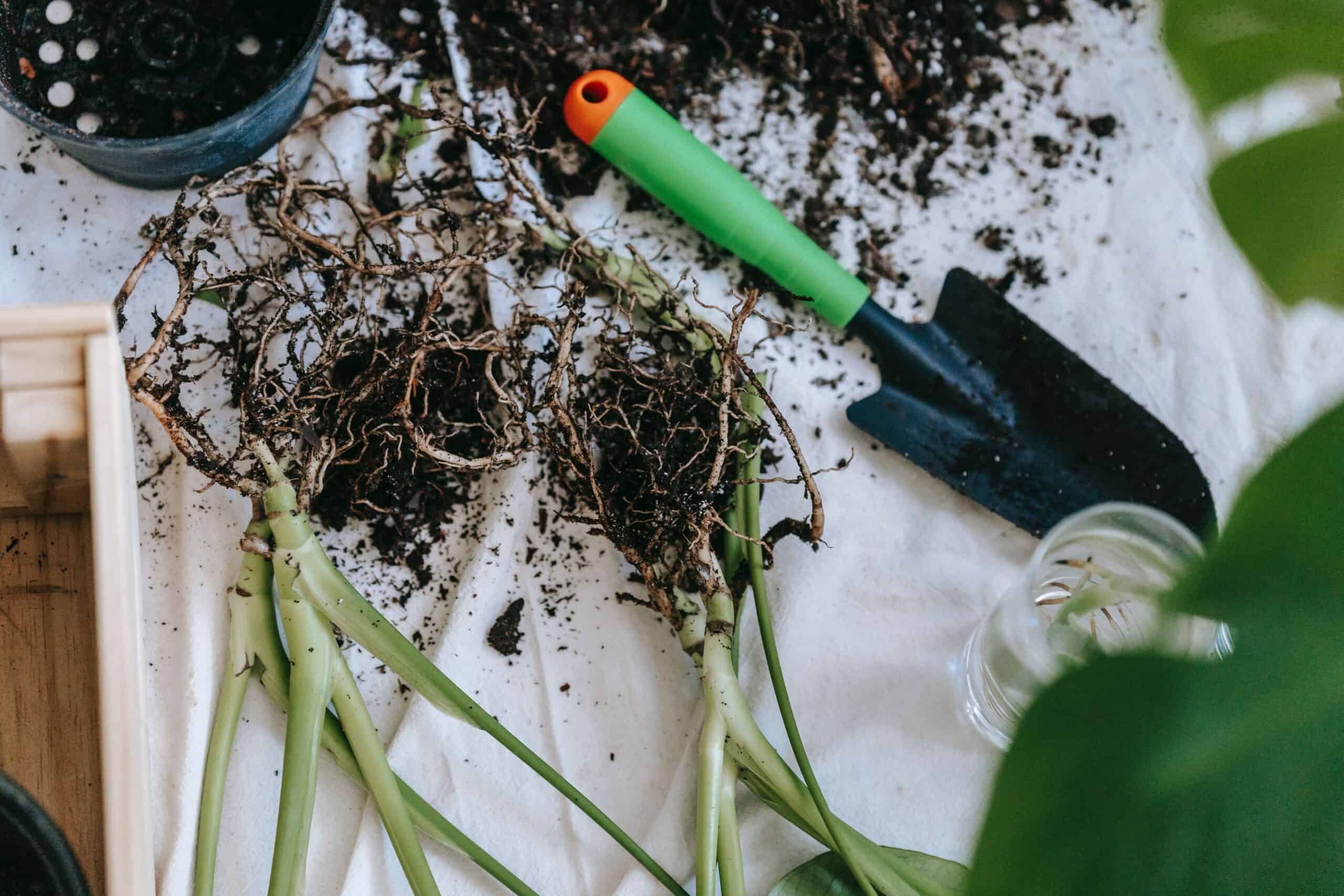



Leave a Reply